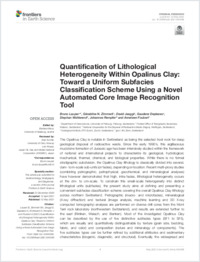Quantification of Lithological Heterogeneity Within Opalinus Clay : Toward a Uniform Subfacies Classification Scheme Using a Novel Automated Core Image Recognition Tool
- Lauper, Bruno Department of Geosciences, University of Fribourg, Fribourg, Switzerland
- Zimmerli, Géraldine N. Department of Geosciences, University of Fribourg, Fribourg, Switzerland
- Jaeggi, David Federal Office of Topography Swisstopo, Wabern, Switzerland
- Deplazes, Gaudenz National Cooperative for the Disposal of Radioactive Waste (Nagra), Wettingen, Switzerland
- Wohlwend, Stephan Geological Institute, ETH Zurich, Zurich, Switzerland
- Rempfer, Johannes geo7 AG, Bern, Switzerland
- Foubert, Anneleen Department of Geosciences, University of Fribourg, Fribourg, Switzerland
- 12.05.2021
Published in:
- Frontiers in Earth Science. - 2021, vol. 9, p. 645596
Aalenian
Toarcian
claystone and shale
mudstone
rock classification
nuclear waste storage
Mont Terri rock laboratory
English
The Opalinus Clay is notable in Switzerland as being the selected host rock for deep geological disposal of radioactive waste. Since the early 1990’s, this argillaceous mudstone formation of Jurassic age has been intensively studied within the framework of national and international projects to characterize its geological, hydrological, mechanical, thermal, chemical, and biological properties. While there is no formal stratigraphic subdivision, the Opalinus Clay lithology is classically divided into several, dam- to m-scale sub-units (or facies), depending on location. Recent multi-proxy studies (combining petrographic, petrophysical, geochemical, and mineralogical analyses) have however demonstrated that high, intra-facies, lithological heterogeneity occurs at the dm- to cm-scale. To constrain this small-scale heterogeneity into distinct lithological units (subfacies), the present study aims at defining and presenting a convenient subfacies classification scheme covering the overall Opalinus Clay lithology across northern Switzerland. Petrographic (macro- and microfacies), mineralogical (X-ray diffraction) and textural (image analysis, machine learning and 3D X-ray computed tomography) analyses are performed on diverse drill cores from the Mont Terri rock laboratory (northwestern Switzerland), and results are extended further to the east (Riniken, Weiach, and Benken). Most of the investigated Opalinus Clay can be described by the use of five distinctive subfacies types (SF1 to SF5), which are visually and quantitatively distinguishable by texture (grain size, bedding, fabric, and color) and composition (nature and mineralogy of components). The five subfacies types can be further refined by additional attributes and sedimentary characteristics (biogenic, diagenetic, and structural). Eventually, the widespread and consistent use of standardized Opalinus Clay subfacies types provides the means to harmonize petrographic descriptions within multidisciplinary research projects, enhance reproducibility of in situ experiments, and further evidence the tight relations between lithology and various rock properties.
- Faculty
- Faculté des sciences et de médecine
- Department
- Département de Géosciences
- Language
-
- English
- Classification
- Geology
- License
-
License undefined
- Identifiers
-
- RERO DOC 330881
- DOI 10.3389/feart.2021.645596
- Persistent URL
- https://folia.unifr.ch/unifr/documents/309582
Statistics
Document views: 244
File downloads:
- Document: 355
